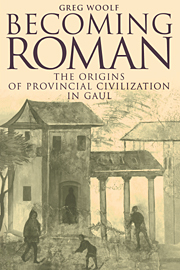Book contents
- Frontmatter
- Contents
- List of illustrations
- Preface
- Abbreviations
- Map 1 Modern regions and river names
- Map 2 Provincial boundaries c. ad 100
- Map 3 Major peoples of Roman Gaul
- 1 On Romanization
- 2 Roman power and the Gauls
- 3 The civilizing ethos
- 4 Mapping cultural change
- 5 Urbanizing the Gauls
- 6 The culture of the countryside
- 7 Consuming Rome
- 8 Keeping faith?
- 9 Being Roman in Gaul
- List of works cited
- Index
6 - The culture of the countryside
Published online by Cambridge University Press: 09 December 2009
- Frontmatter
- Contents
- List of illustrations
- Preface
- Abbreviations
- Map 1 Modern regions and river names
- Map 2 Provincial boundaries c. ad 100
- Map 3 Major peoples of Roman Gaul
- 1 On Romanization
- 2 Roman power and the Gauls
- 3 The civilizing ethos
- 4 Mapping cultural change
- 5 Urbanizing the Gauls
- 6 The culture of the countryside
- 7 Consuming Rome
- 8 Keeping faith?
- 9 Being Roman in Gaul
- List of works cited
- Index
Summary
Beyond the city
What significance should the countryside have in an investigation of how Gauls became Romans? One common strategy employed by historians is to use the culture of the countryside to puncture the pretensions of the town. There is something to be gained rhetorically from setting Gallo-Roman cities against the vast backdrop of their rural hinterlands, if only to illustrate how few, small and far apart urban centres were in some parts of the Gallic provinces. It does not follow, however, either that Roman culture was restricted to the new cities of Gaul, or that the countryside was excluded from processes of cultural change.
In fact, every aspect of Gallic life was to some extent transformed by integration into the empire, including most spheres of rural life. New crops were introduced, particularly for arboriculture, and the geographical range of some Mediterranean species, including the vine and the olive, was extended inland. New technologies were adopted, for example new methods of storing grain, of processing agricultural produce and of draining marshes. These changes were perhaps not as significant as the agricultural revolution that had begun and gathered pace in the centuries immediately preceding the Roman conquest. The first large scale production of metal agricultural tools was associated in the late iron age with demographic growth, attested by settlement evidence as well as by classical accounts of migrations and huge armies, and with agricultural expansion involving both some deforestation and the cultivation of heavier soils.
- Type
- Chapter
- Information
- Becoming RomanThe Origins of Provincial Civilization in Gaul, pp. 142 - 168Publisher: Cambridge University PressPrint publication year: 1998

